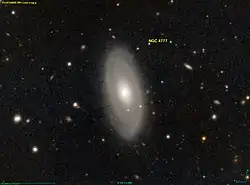NGC 4777
NGC 4777 is an intermediate spiral ring galaxy.[4] It is estimated to be about 180 million light-years (or about 54 Megaparsecs) away from the Sun.[3] It was discovered on March 3, 1786 by the astronomer William Herschel.[5]
| NGC 4777 | |
|---|---|
 Pan-STARRS image of NGC 4777 | |
| Observation data (J2000 epoch) | |
| Constellation | Virgo |
| Right ascension | 12h 53m 58.54196s[1] |
| Declination | −08° 46′ 32.5147″[1] |
| Redshift | 0.011905[2] |
| Helio radial velocity | 3548 km/s[2] |
| Distance | 175.1 Mly (53.70 Mpc)[3] |
| Apparent magnitude (B) | 14.5[2] |
| Characteristics | |
| Type | (R)SAB(s)a:[4] |
| Other designations | |
| MCG-01-33-044, PGC 43852[2] | |
References
- Brown, A. G. A.; et al. (Gaia collaboration) (August 2018). "Gaia Data Release 2: Summary of the contents and survey properties". Astronomy & Astrophysics. 616. A1. arXiv:1804.09365. Bibcode:2018A&A...616A...1G. doi:10.1051/0004-6361/201833051.
- "NGC 4777". SIMBAD. Centre de données astronomiques de Strasbourg. Retrieved 2021-02-03.
- Tully, R. Brent; Courtois, Hélène M.; Sorce, Jenny G. (2016). "Cosmicflows-3". The Astronomical Journal. 152 (2): 21. arXiv:1605.01765. Bibcode:2016AJ....152...50T. doi:10.3847/0004-6256/152/2/50. 50.
- "Results for object NGC 4777 (NGC 4777)". NASA/IPAC Extragalactic Database. California Institute of Technology. Retrieved 2021-02-03.
- Seligman, Courtney. "New General Catalogue objects: NGC 4750 - 4799". cseligman.com. Retrieved 2021-02-03.
External links
- NGC 4777 on WikiSky: DSS2, SDSS, GALEX, IRAS, Hydrogen α, X-Ray, Astrophoto, Sky Map, Articles and images
This article is issued from Wikipedia. The text is licensed under Creative Commons - Attribution - Sharealike. Additional terms may apply for the media files.
